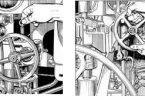- whenever possible, conduct ballast water exchange at least 200 nautical miles from the nearest land and in water at least 200 metres in depth, taking into account Guidelines developed by IMO;
- in cases where the ship is unable to conduct ballast water exchange as above, this should be as far from the nearest land as possible, and in all cases at least 50 nautical miles from the nearest land and in water at least 200 metres in depth.
When these requirements cannot be met areas may be designated where ships can conduct ballast water exchange. All ships shall remove and dispose of sediments from spaces designated to carry ballast water in accordance with the provisions of the ships’ ballast water management plan (Regulation B-4).
Annex – Section C Additional measures
A Party, individually or jointly with other Parties, may impose on ships additional measures to prevent, reduce, or eliminate the transfer of Harmful Aquatic Organisms and Pathogens through ships’ Ballast Water and Sediments.
In these cases, the Party or Parties should consult with adjoining or nearby States that may be affected by such standards or requirements and should communicate their intention to establish additional measure(s) to the Organization at least 6 months, except in emergency or epidemic situations, prior to the projected date of implementation of the measure(s). When appropriate, Parties will have to obtain the approval of IMO.
Annex – Section D Standards for Ballast Water Management
There is a ballast water exchange standard and a ballast water performance standard. Ballast water exchange could be used to meet the performance standard:
Regulation D-1 Ballast Water Exchange Standard – Ships performing Ballast Water exchange shall do so with an efficiency of 95 per cent volumetric exchange of Ballast Water. For ships exchanging ballast water by the pumping-through method, pumping through three times the volume of each ballast water tank shall be considered to meet the standard described. Pumping through less than three times the volume may be accepted provided the ship can demonstrate that at least 95 percent volumetric exchange is met.
Regulation D-2 Ballast Water Performance Standard – Ships conducting ballast water management shall discharge less than 10 viable organisms per cubic metre greater than or equal to 50 micrometres in minimum dimension and less than 10 viable organisms per milliliter less than 50 micrometres in minimum dimension and greater than or equal to 10 micrometres in minimum dimension; and discharge of the indicator microbes shall not exceed the specified concentrations.
The indicator microbes, as a human health standard, include, but are not be limited to:


